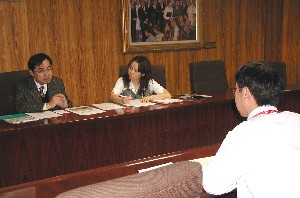Over the Years
Home > Over the Years > Over the Fiscal Years (2000 APR - 2010 MAR) > Korea: Medical Doctor Training Program
Korea: Medical Doctor Training Program
Name and Position:
Sang-Moo Lim, M.D.
Director
National Radiation Emergency Medical Center,
Korea Institute of Radiological & Medical Sciences
Period:
Host Organization:
Hiroshima University Hospital
Radiation Effects Research Foundation
Hiroshima Red Cross Hospital & Atomic-bomb Survivors Hospital
Hiroshima University Research Institute for Radiation Biology & Medicine
Hiroshima A-bomb Casualty Council
Hiroshima Municipal Hospital
Training Course:

Meeting at the Hiroshima Red Cross Hospital & Atomic-bomb Survivors Hospital
Dr. Lim's Impressions:
1 Guidance by a member of HICARE was very much helpful both for visiting several institutions and for Japanese cultural experience.
2 Arrangement for meeting with many experts in different institutes was effective to show the capability of Hiroshima for the medical service and research activities in A-bomb survivors and related medicine.
3 Hiroshima became a center for radiation emergency in west-Japan, and 2/3 of Korean Nuclear Power plants face west-Japan, so Korean-Japan cooperation should be promoted in this field.
Dr. Lim's Medical Activities in Korea:
1 As a nuclear medicine physician, I am responsible for my PET center and radioisotope therapy for cancer patients. Nuclear medicine is positively using radioactivity for human health, and can make people understand radioactivity reasonably. Pet become very helpful in management of cancer, and radioisotope therapy will be one of the standard treatment method for cancer, because physiologically targeted therapy is possible.
2 Medical preparedness for the radiation emergency is important not only for nuclear power plant and industry but also for radioactive terror. To be prepared, regular education and exercise is important. Facilities for the radiation emergency can be used for radioisotope therapy, when there is no accident. I am trying to have better training courses, and to use the facilities efficiently.




